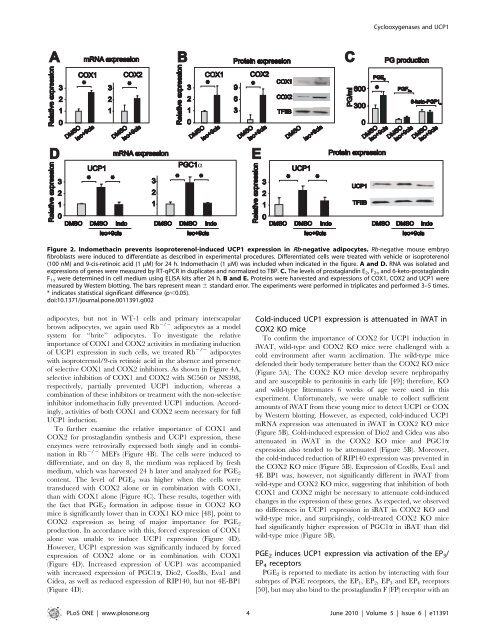The obesogenic effects of polyunsaturated fatty acids are dependent ...
The obesogenic effects of polyunsaturated fatty acids are dependent ...
The obesogenic effects of polyunsaturated fatty acids are dependent ...
Create successful ePaper yourself
Turn your PDF publications into a flip-book with our unique Google optimized e-Paper software.
Cyclooxygenases and UCP1<br />
Figure 2. Indomethacin prevents isoproterenol-induced UCP1 expression in Rb-negative adipocytes. Rb-negative mouse embryo<br />
fibroblasts were induced to differentiate as described in experimental procedures. Differentiated cells were treated with vehicle or isoproterenol<br />
(100 nM) and 9-cis-retinoic acid (1 mM) for 24 h. Indomethacin (1 mM) was included when indicated in the figure. A and D. RNA was isolated and<br />
expressions <strong>of</strong> genes were measured by RT-qPCR in duplicates and normalized to TBP. C. <strong>The</strong> levels <strong>of</strong> prostaglandin E 2 ,F 2a and 6-keto-prostaglandin<br />
F 1a were determined in cell medium using ELISA kits after 24 h. B and E. Proteins were harvested and expressions <strong>of</strong> COX1, COX2 and UCP1 were<br />
measured by Western blotting. <strong>The</strong> bars represent mean 6 standard error. <strong>The</strong> experiments were performed in triplicates and performed 3–5 times.<br />
* indicates statistical significant difference (p,0.05).<br />
doi:10.1371/journal.pone.0011391.g002<br />
adipocytes, but not in WT-1 cells and primary interscapular<br />
brown adipocytes, we again used Rb 2/2 adipocytes as a model<br />
system for ‘‘brite’’ adipocytes. To investigate the relative<br />
importance <strong>of</strong> COX1 and COX2 activities in mediating induction<br />
<strong>of</strong> UCP1 expression in such cells, we treated Rb 2/2 adipocytes<br />
with isoproterenol/9-cis retinoic acid in the absence and presence<br />
<strong>of</strong> selective COX1 and COX2 inhibitors. As shown in Figure 4A,<br />
selective inhibition <strong>of</strong> COX1 and COX2 with SC560 or NS398,<br />
respectively, partially prevented UCP1 induction, whereas a<br />
combination <strong>of</strong> these inhibitors or treatment with the non-selective<br />
inhibitor indomethacin fully prevented UCP1 induction. Accordingly,<br />
activities <strong>of</strong> both COX1 and COX2 seem necessary for full<br />
UCP1 induction.<br />
To further examine the relative importance <strong>of</strong> COX1 and<br />
COX2 for prostaglandin synthesis and UCP1 expression, these<br />
enzymes were retrovirally expressed both singly and in combination<br />
in Rb 2/2 MEFs (Figure 4B). <strong>The</strong> cells were induced to<br />
differentiate, and on day 8, the medium was replaced by fresh<br />
medium, which was harvested 24 h later and analyzed for PGE 2<br />
content. <strong>The</strong> level <strong>of</strong> PGE 2 was higher when the cells were<br />
transduced with COX2 alone or in combination with COX1,<br />
than with COX1 alone (Figure 4C). <strong>The</strong>se results, together with<br />
the fact that PGE 2 formation in adipose tissue in COX2 KO<br />
mice is significantly lower than in COX1 KO mice [48], point to<br />
COX2 expression as being <strong>of</strong> major importance for PGE 2<br />
production. In accordance with this, forced expression <strong>of</strong> COX1<br />
alone was unable to induce UCP1 expression (Figure 4D).<br />
However, UCP1 expression was significantly induced by forced<br />
expression <strong>of</strong> COX2 alone or in combination with COX1<br />
(Figure 4D). Increased expression <strong>of</strong> UCP1 was accompanied<br />
with increased expression <strong>of</strong> PGC1a, Dio2, Cox8b, Eva1 and<br />
Cidea, as well as reduced expression <strong>of</strong> RIP140, but not 4E-BP1<br />
(Figure 4D).<br />
Cold-induced UCP1 expression is attenuated in iWAT in<br />
COX2 KO mice<br />
To confirm the importance <strong>of</strong> COX2 for UCP1 induction in<br />
iWAT, wild-type and COX2 KO mice were challenged with a<br />
cold environment after warm acclimation. <strong>The</strong> wild-type mice<br />
defended their body temperature better than the COX2 KO mice<br />
(Figure 5A). <strong>The</strong> COX2 KO mice develop severe nephropathy<br />
and <strong>are</strong> susceptible to peritonitis in early life [49]; therefore, KO<br />
and wild-type littermates 6 weeks <strong>of</strong> age were used in this<br />
experiment. Unfortunately, we were unable to collect sufficient<br />
amounts <strong>of</strong> iWAT from these young mice to detect UCP1 or COX<br />
by Western blotting. However, as expected, cold-induced UCP1<br />
mRNA expression was attenuated in iWAT in COX2 KO mice<br />
(Figure 5B). Cold-induced expression <strong>of</strong> Dio2 and Cidea was also<br />
attenuated in iWAT in the COX2 KO mice and PGC1a<br />
expression also tended to be attenuated (Figure 5B). Moreover,<br />
the cold-induced reduction <strong>of</strong> RIP140 expression was prevented in<br />
the COX2 KO mice (Figure 5B). Expression <strong>of</strong> Cox8b, Eva1 and<br />
4E BP1 was, however, not significantly different in iWAT from<br />
wild-type and COX2 KO mice, suggesting that inhibition <strong>of</strong> both<br />
COX1 and COX2 might be necessary to attenuate cold-induced<br />
changes in the expression <strong>of</strong> these genes. As expected, we observed<br />
no differences in UCP1 expression in iBAT in COX2 KO and<br />
wild-type mice, and surprisingly, cold-treated COX2 KO mice<br />
had significantly higher expression <strong>of</strong> PGC1a in iBAT than did<br />
wild-type mice (Figure 5B).<br />
PGE 2 induces UCP1 expression via activation <strong>of</strong> the EP 3 /<br />
EP 4 receptors<br />
PGE 2 is reported to mediate its action by interacting with four<br />
subtypes <strong>of</strong> PGE receptors, the EP 1 ,EP 2 ,EP 3 and EP 4 receptors<br />
[50], but may also bind to the prostaglandin F (FP) receptor with an<br />
PLoS ONE | www.plosone.org 4 June 2010 | Volume 5 | Issue 6 | e11391
















